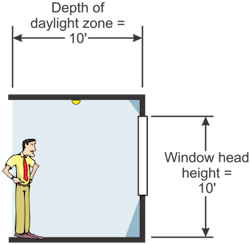Understanding LLLC Technology and Energy Code Compliance
Energy code requirements for new construction and major renovation projects have continued to evolve over the years, adding more complexity for those responsible for designing the lighting and control systems, as well as for the teams installing them.
Energy code compliance for lighting revolves around the installed watts per square foot and integrating both occupancy and daylight sensors. States often adopt codes based on the most recent version of International Energy Conservation Code or American Society of Heating, Refrigerating and Air-Conditioning Engineers, and it is not uncommon to see modified versions of these standards being used at state/municipal levels. All of these intricate details can make it extremely challenging to be assured that your lighting and controls design meets the local code.
Using luminaire level lighting controls, commonly referred to as LLLCs, with factory-integrated wireless daylight and occupancy sensors can provide code compliance right out of the box. Factory-set defaults for the sensor behaviors are often set to California’s Title 24 requirements, which is typically the most stringent code in the country. This indicates that by using these systems, an installation will not only meet but also likely exceed any local code.
Verification that a chosen system, in fact, meets local energy code requirements is a conversation to be addressed with any individual LLLC manufacturer as part of the design and application process.
While local codes vary throughout the nation, let’s use an example of a typical application, an office space, where it’s standard practice to use the same luminaire in the majority of the design. Most energy codes require occupancy sensors installed in all areas except for busy common areas such as a lobby. Code also requires daylight harvesting for luminaires that are within both a primary and secondary daylighting zone. A daylighting zone is any space near a window or a skylight; each state or, in some cases, cities will have their own unique rule for this calculation.
The majority of codes specify that fixtures located within 20 ft. to 25 ft. of windows fall under a primary or secondary daylight zone. The calculation is based on the window height and the distance of the fixtures to that window. For example, if the height of the windows is 10 ft., then any fixtures located within 10 ft. of that window is in the primary zone and are required to have daylight harvesting, which is similar for skylights as well. The secondary zone would be any fixture located from 10 ft. to 25 ft. from the window and will also typically require daylight harvesting, but effective light penetration at this distance needs to be considered (see figures below).
So now what appears to be a straightforward, simple lighting design quickly becomes complex. Even if an experienced designer can do this quickly, it can be difficult for an installer to ensure that the correct fixtures are placed within each zone. Power circuit design also may not align with zonal sensor wiring, creating more complex design and installation challenges.
LLLCs can help eliminate this time and labor expense. So, how does it work? If all luminaires are LLLCs, they have an embedded sensor that provides occupancy and daylight harvesting capabilities. Specify, order and install just one luminaire type, and then program and enable these functions as required by code (if needed). In addition, wireless LLLCs can be powered by any available power circuit, simplifying the process from design to installation.
An LLLC streamlines energy code compliance during the project design process, and, just as importantly, allows installers to better understand their cost strategy at the time of bid. All while confidently fulfilling and exceeding energy code obligations. It’s that simple!
Pilant has over 25 years of experience working within the lighting and energy industries. She has worked at Evergreen Consulting Group since 2009. She can be reached at [email protected].


